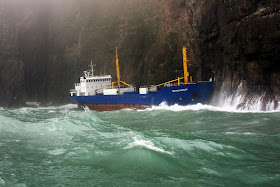 Island of hell, scenery of shipwrecks and drama.
Island of hell, scenery of shipwrecks and drama.
Bjørnøya (Bear Island) is a small remote island in the Barents Sea, within the Arctic circle, 450 km north of Tromsø, about midway between the Norwegian mainland and Spitsbergen.
Most of the island's 176 km2 are flat, with some mountainous areas in the south. The Miseryfjellet mountain is the tallest with 536 m.

Cliffs with the Miseryfjellet in background
Approximately 600 small lakes are scattered around the island. The interior of Bjørnøya is quite barren and vegetation is mostly lacking.

At the meeting point of the warm water of the Gulf Stream going north and the cold westerly Siberian Current, the climate is milder than expected. But the temperature difference between the warm and cold water produces dense fog which for the most of the summer engulfs the island.
The island is uninhabited, but there is a permanently staffed Norwegian weather station at the north coast, the most friendly area.

The south: a threatening profile
High cliffs and sea stacks rise up into the clouds that almost perpetually shroud Bear Island, under a windy, rough and foggy weather that helped to create it's reputation.
To land anywhere is a challenge and something you can do only in exceptionally good weather conditions. The lack of protected bays and the rough weather with strong winds and frequent fog make visiting Bjørnøya frequently impossible.
The island was discovered by the Dutch polar explorer Willem Barents in 1596; his crew killed a bear and called the island after its bears, "Beeren Eyeland". It came under Norwegian sovereignty together with the rest of Svalbard islands in 1925.
Since 1918 a radio and weather station has been active on the island, and is still manned today. In 1947 a new radio meteorological station was built in Herwighamna. New instruments were installed in 1949.
Today it is run by a crew of nine people, which is changed twice a year. Transition to digital recording took place in 1986. The magnetometer is operated with the assistance of the Meteorological Institute of Norway and located at the new meteorological station.
Herwighamna meteorological station
Some old buldings of the first 1947 station are part of the new complex, as a small museum:
The northern coast has some quiet bays where small boats can land in good weather:
The amazing “Pearly gates” (Perleporten) tunnel, more than 180 meters long.
Through Cape Kolthoff, over thousands of years, the ocean carved a long tunnel, called the Pearly Gates.

After the entrance, an interior "pool" hidden from outside - a secret explored in Alistair Maclean's thriller.
A recent wreck increased the island's bad reputation: in May 2009, the "Petrozavodsk”, a Russian vessel, ran aground by the south coast of Bear Island, near the fearful cliffs that are breeding ground for sea bird colonies.
Later, the ship broke in two and was finally removed.
Some diesel and oil leaked into the ocean beneath the cliffs where thousands of guillemots usually nest.


Guillemot colony



























Very interresting site. We do not hear that much from those wonderful northern lands. Is it possible, if you have any, to have more informations? krussn@gmail.com
ReplyDeleteThank you in advance,
NB.PS